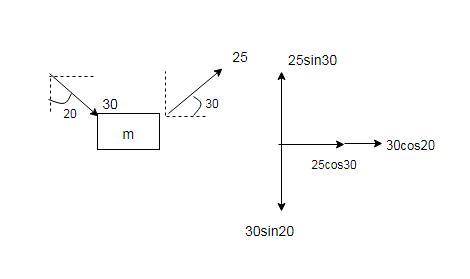
Physics, 31.07.2019 04:10 suselygonza
You and a friend try to move a 50.0 kg box over a smooth floor (no friction). you push down and right with a force 30.0 n, at angle of 20 degrees below the horizontal. your friend ties a rope to the front of the box and pulls with a 25.0 n force, at an angle 30 degrees above the horizontal. what is the acceleration of the box in the horizontal direction? assuming the box does not move in the vertical direction, what is the normal force on the box?

Answers: 3


Another question on Physics

Physics, 22.06.2019 00:30
What is the acceleration of a spaceship that is initially at rest and then speeds up to 220 m/s in 20 seconds
Answers: 1

Physics, 22.06.2019 05:00
At time t=0, a particle is located at the point (3,6,9). it travels in a straight line to the point (5,2,7), has speed 8 at (3,6,9) and constant acceleration 2i−4j−2k. find an equation for the position vector of the particle.
Answers: 2

Physics, 22.06.2019 11:50
Find the dimensions and area of the largest rectangle that can be inscribed in the upper half of the ellipse. (give your answers in terms of a and b. enter the dimensions as a comma-separated list.)
Answers: 2

Physics, 22.06.2019 15:00
Astudent throws a water balloon with speed v0 from a height h = 1.76 m at an angle θ = 21° above the horizontal toward a target on the ground. the target is located a horizontal distance d = 9.5 m from the student’s feet. assume that the balloon moves without air resistance. use a cartesian coordinate system with the origin at the balloon's initial position. (a) what is the position vector, rtarge t, that originates from the balloon's original position and terminates at the target? put this in terms of h and d, and represent it as a vector using i and j. (b) in terms of the variables in the problem, determine the time, t, after the launch it takes the balloon to reach the target. your answer should not include h. (c) create an expression for the balloon's vertical position as a function of time, y(t), in terms of t, vo, g, and θ. (d) determine the magnitude of the balloon's initial velocity, v0, in meters per second, by eliminating t from the previous two expressions.
Answers: 3
You know the right answer?
You and a friend try to move a 50.0 kg box over a smooth floor (no friction). you push down and righ...
Questions

Advanced Placement (AP), 18.09.2021 14:00


Computers and Technology, 18.09.2021 14:00

English, 18.09.2021 14:00



English, 18.09.2021 14:00




Physics, 18.09.2021 14:00



History, 18.09.2021 14:00




Spanish, 18.09.2021 14:00









